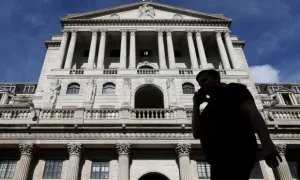
The Bank of England has dropped the broadest possible hint that the next move in interest rates will be downwards after forecasting inflation will fall below 2% within months, despite keeping borrowing costs unchanged for a fourth consecutive time.
Threadneedle Street stressed that more evidence was required that inflation would stick at the target set by the government before the Bank could deliver a first cut to borrowing costs since the start of the pandemic. It warned that risks from fast-rising prices remained amid the cost of living crisis.
In a widely expected decision, the Bank’s monetary policy committee (MPC) voted by a majority to keep interest rates at the current level of 5.25%, the highest level since the 2008 financial crisis.
However, one member of the panel – the independent economist Swati Dhingra – pushed for an immediate reduction in borrowing costs, in a powerful signal to financial markets that the central bank was edging closer to taking action.
The Bank issued a sharp downgrade in forecasts for inflation, pencilling in a fall below 2% in May for the first time since early 2021, although it warned it was likely to return above the target rate later this year amid robust pay growth in the British economy and the fading impact from lower energy prices.
Andrew Bailey, the Bank’s governor, said: “We have had good news on inflation over the past few months. It has fallen a long way, from 10% a year ago to 4%. But we need to see more evidence that inflation is set to fall all the way to the 2% target, and stay there, before we can lower interest rates.”
Financial markets had predicted rates would be left unchanged for a fourth consecutive time after a steady decline in inflation over recent months, despite a small increase in December from 3.9% to 4%, with City investors anticipating a first rate cut from as early as June.
The Bank has left borrowing costs unchanged since September, having paused its most aggressive hiking cycle in decades. The central bank lifted rates from a record low of 0.1% in December 2021, driving up the cost of mortgages and loans for millions of households.
